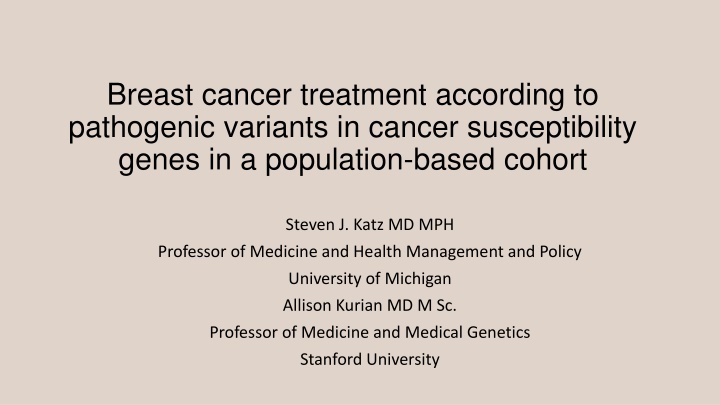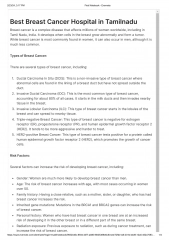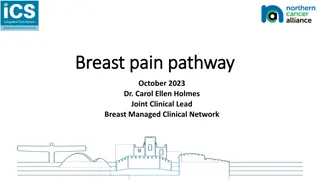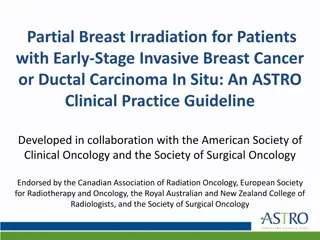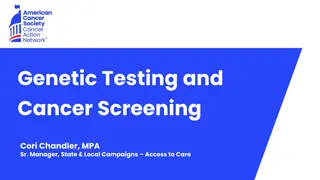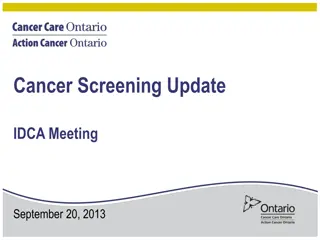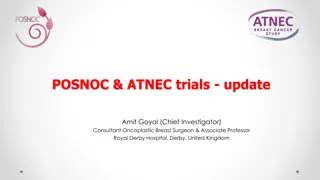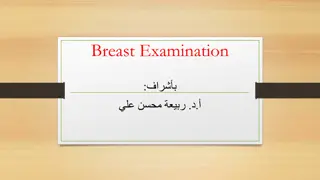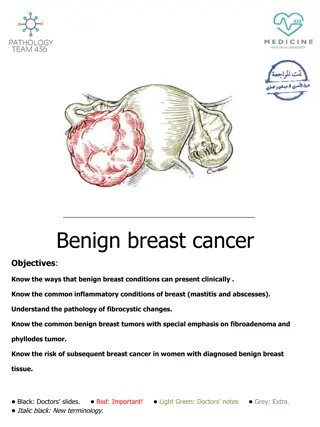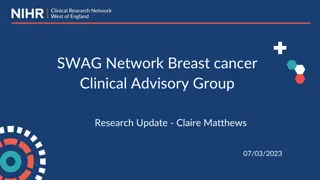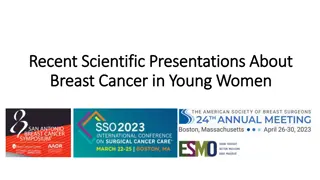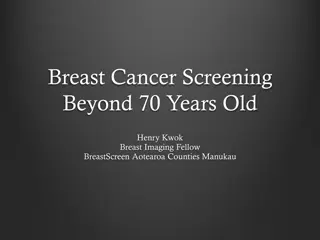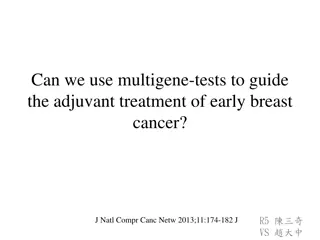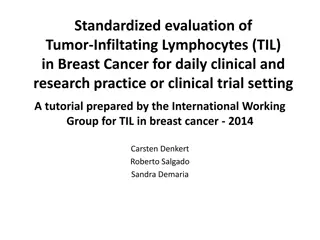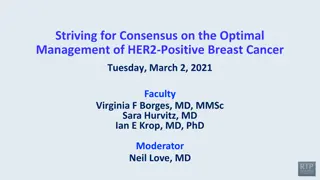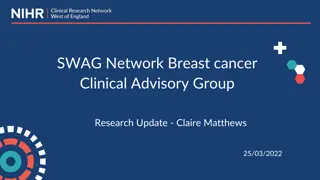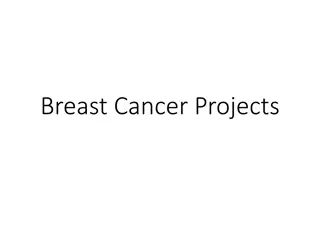Breast Cancer Genetic Variants and Treatment Guidelines
Recent research highlights the importance of genetic testing for cancer susceptibility genes in breast cancer patients to guide personalized treatment plans. Guidelines based on pathogenic variants in genes like BRCA1, BRCA2, and others provide insights on relative cancer risks and recommendations for surveillance and risk-reducing strategies.
Download Presentation

Please find below an Image/Link to download the presentation.
The content on the website is provided AS IS for your information and personal use only. It may not be sold, licensed, or shared on other websites without obtaining consent from the author.If you encounter any issues during the download, it is possible that the publisher has removed the file from their server.
You are allowed to download the files provided on this website for personal or commercial use, subject to the condition that they are used lawfully. All files are the property of their respective owners.
The content on the website is provided AS IS for your information and personal use only. It may not be sold, licensed, or shared on other websites without obtaining consent from the author.
E N D
Presentation Transcript
Breast cancer treatment according to pathogenic variants in cancer susceptibility genes in a population-based cohort Steven J. Katz MD MPH Professor of Medicine and Health Management and Policy University of Michigan Allison Kurian MD M Sc. Professor of Medicine and Medical Genetics Stanford University
Guidelines 2019 Gene Breast Relative Risk Ovarian Relative Risk Other Cancer Risks U.S. Clinical Practice Guidelines (NCCN, ASCO, ACS) Ataxia Telangiectasia Syndrome in homozygotes; maybe colon, pancreas, prostate Screening breast magnetic resonance imaging (MRI), start age 40; insufficient data to recommend risk- reducing salpingo-oophorectomy (RRSO) ATM 2 to 3-fold Potential increase BARD1 Potential increase Insufficient evidence Uncertain Insufficient evidence to guide management Breast MRI at 25,recommendRRSO @40, discuss RR mastectomy (RRM) Pancreas, prostate; melanoma BRCA1 10-fold 20 to 40-fold BRCA2 10-fold 10 to 20-fold Pancreas, prostate; melanoma Breast MRI at 25, recommend RRSO @45, discuss RRM BRIP1 Insufficient evidence 2 to 3-fold Autosomal recessive (AR) risk Consider RRSO at 45-50 CDH1 CHEK2 5-fold (lobular) 2 to 3-fold No increased risk No increased risk Gastric Colon; maybe thyroid Breast MRI at 30, discuss RR gastrectomy Breast MRI at 40, earlier colonoscopy MLH1, MSH2, MSH6, PMS2, EPCAM Consider RRSO and hysterectomy, annual colonoscopy, biannual endoscopy Insufficient evidence 5 to 10-fold Colon, uterine, pancreas, others NBN 2 to 3-fold Insufficient evidence Nijmegen Breakage Syndrome (AR) Breast MRI at 40 NF1 2 to 3-fold No increased risk CNS, peripheral nerve sheath, GIST Breast MRI at 30 PALB2 3 to 5-fold Insufficient evidence Pancreas Breast MRI at 30, discuss RRM PTEN At least 5-fold No increased risk Thyroid, colon, renal, endometrial Breast MRI at 30, discuss RRM, discuss hysterectomy RAD51C Insufficient evidence 2 to 3-fold Uncertain Consider RRSO at 45-50 RAD51D Insufficient evidence 2 to 3-fold Uncertain Consider RRSO at 45-50 STK11 At least 5-fold Non-epithelial: 2 to 3-fold Pancreas, colon, sex cord-stromal Breast MRI at 25, discuss RRM Sarcoma, leukemia, adrenocortical, brain, etc. Breast MRI at 20, discuss RRM; whole-body MRI, colonoscopy/endoscopy, complete blood count, etc. TP53 At least 10-fold No increased risk
Why the surge in multigene panel testing after diagnosis of breast cancer? Established clinical utility of BRCA1 and BRCA2 testing Potential benefit of trace-back cascade genetic cancer risk evaluation in relatives in high risk families Plummeting costs of testing and competitive marketing since 2013 High optics of genetic precision oncology Nature of the beast regarding the diffusion of medical testing (vs treatment) Less concern about direct harm to patients Less scrutiny of the benefits Fewer insurance related barriers
Recommendations for genetic risk evaluation for hereditary breast and ovarian cancer All women diagnosed with ovarian cancer N=220,000 Many women diagnosed with breast cancer N=3.5 million Adult women with strong family history of cancer N=15 million Ashkenazi Jewish women N=2 million Known pathogenic variant in 1stdegree relatives N= unknown
Test results inform relative risk of future cancer vs absolute benefit of the different treatment options Patients must juggle two different schemas: prevention of new cancers vs treatment for the one they have Clinical utility of testing is evolving Wide variability in cancer relative risk estimates for individual patients with pathogenic variants The growing problem of addressing variant of unknown significance (VUS) Test results have implications for relatives Major challenges of incorporating genetic risk evaluation into treatment decision workflow Katz SJ, Kurian A, Morrow M JAMA 2015
Georgia Georgia- -California Genetic Testing California Genetic Testing Linkage Initiative Linkage Initiative Steven J. Katz MD MPH Allison Kurian MD MS Kevin Ward Ph.D Dennis Deapen Ph.D Ann Hamilton Ph.D Lynne Penberthy MD MPH Valentina Petkov MD Nicola Schussler
GA/CA SEER Genetic Testing Initiative Testing Laboratory (Invitae) Testing Laboratory (Myriad) Testing Laboratory (BioRef) Testing Laboratory (Ambry) SEER-Genetics Dataset N=190,000 BC and 15,000 ovarian patients Patient demographics Tumor characteristics Treatment Survival Genetic tests done Detailed test results: Gene/s tested Positive, negative, or uncertain Information Management Services (IMS) Links and de-identifies data California Cancer Registry Breast cancer cases, 2013-17 Ovarian cancer cases, 2013-17 Georgia Cancer Registry Breast cancer cases, 2013-17 Ovarian cancer cases, 2013-17
% had any genetic test among patients with breast cancer by year (N= 158,480) 100 90 80 70 60 % 50 40 30 20 10 0 2013 2014 2015 2016
% had multigene panel testing among testers (breast cancer) by quarter and year (N=39,563) 100 90 80 70 60 50 % 40 30 20 10 0 2013 2014 2015 2016 Q1 Q2 Q3 Q4
Research questions What is the association of genetic test results with locoregional and systemic treatment?: Use of contralateral prophylactic mastectomy (CPM) in candidates for unilateral surgery Pathogenic variant should be associated with more extensive surgery Use of irradiation in patients with indications for it Pathogenic variant should not be associated with use of radiation Use of systemic chemotherapy in patients with no definitive indication for it Pathogenic variant should not be associated with use of chemotherapy
82,017 Breast Cancer Patients Diagnosed 2014-15 65,669 Not Linked To Test Result 16,348 Tested Patients Candidate for unilateral surgery Indication for post-lumpectomy radiation No definitive indication for chemotherapy 3,006 Surgery Type Not Identified 1,541 Radiation Status Not Available 709 Chemotherapy Status Not Available 116 Stage IV 466 Stage IV 4,415 Stage 0, III, IV 8,520 Non-Lumpectomy 3,724 Triple Negative, HER2 pos, or RS 30+ 1534 Bilateral Tumor 1,201 Incomplete Information 652 Incomplete Information 347 Neoadjuvant Chemotherapy 693 Incomplete Information 10,491 Analytical Sample 5,169 Analytical Sample 6,460 Analytic Sample
Distribution of test result by clinical cohort Test Result Candidates for unilateral surgery Indication for post- lumpectomy radiation No definitive indication for chemotherapy Negative 7,944 (76%) 4095 (79%) 5013 (78%) VUS Only 1,729 (16%) 853 (17%) 1012 (16%) BRCA 1 or 2 538 (5%) 101 (2%) 269 (4%) Other Path Variant 280 (3%) 120 (2%) 166 (3%) Total 10,491 (100%) 5,169 (100%) 6,460 (100%)
Treatment rates by genetic test result Adjusted percentage (95% CI) Genetic Test Results Bilateral Mastectomy Radiation Therapy Chemotherapy Negative 23.6 (22.6 - 24.5) 76.1 (74.7 - 77.4) 23.0 (21.6 - 24.4) VUS only 24.4 (22.4 - 26.6) 76.3 (73.3 - 79.1) 23.0 (20.2 - 26.1) BRCA1/2 PV 57.5 (52.9 - 62.0) 47.6 (37.6 - 57.9) 36.5 (29.7 - 43.9) Other PV 34.0 (28.5 - 34.0) 69.3 (60.5 - 76.9) 28.8 (21.5 - 37.3)
Adjusted odds of receipt of CPM Test Result Negative (ref) BRCA Mutation Other Mutation VUS 4.40 (3.62-5.33) 1.67 (1.29-2.17) 1.05 (0.93-1.19) Age (decades) 0.68 (0.65-0.71) Race White (ref) Asian Black Latina 0.67 (0.57-0.79) 0.67 (0.57-0.78) 0.73 (0.63-0.85) Private Insurance (vs. other) 1.25 (1.13-1.39) Neighborhood SES Low (ref) Medium High 1.11 (0.98-1.25) 1.18 (1.04-1.33) Stage 0 (reference) I II III 0.87 (0.75-1.00) 1.14 (0.99-1.32) 1.62 (1.36-1.94) Grade 1 (ref) 2 3 ER, PR, HER2 Status ER+/PR+, HER2- (ref) ER-, PR-, HER2- HER2+ 1.11 (0.97-1.28) 1.07 (0.92-1.24) 0.0 1.0 2.0 3.0 4.0 5.0
Adjusted odds ratio for receipt of radiation Test Result Negative (ref) BRCA Mutation Other Mutation VUS 0.29 (0.19-0.43) 0.71 (0.48-1.05) 1.01 (0.85-1.21) 1.04 (0.98-1.1) Age (decades) Race White (ref) Asian Black Latina 1.14 (0.90-1.44) 1.21 (0.95-1.54) 0.95 (0.77-1.17) 1.35 (1.16-1.56) Private Insurance (vs. other) Neighborhood SES Low (ref) Medium High 1.25 (1.04-1.49) 1.45 (1.21-1.73) Stage 0 (reference) I II III 2.27 (1.89-2.72) 1.86 (1.53-2.27) 1.14 (0.80-1.63) Grade 1 (ref) 2 3 0.95 (0.8-1.13) 0.94 (0.76-1.15) ER, PR, HER2 Status ER+/PR+, HER2- (ref) ER-, PR-, HER2- HER2+ 0.71 (0.57-0.89) 0.55 (0.45-0.68) 0.0 1.0 2.0 3.0
Adjusted odds of receipt of chemotherapy Test Result Negative (ref) BRCA Mutation Other Mutation VUS 1.92 (1.4-2.64) 1.35 (0.91-2.01) 1.00 (0.84-1.20) Age (decades) 0.59 (0.55-0.63) Race White (ref) Asian Black Latina 1.17 (0.94-1.44) 1.11 (0.88-1.40) 1.09 (0.88-1.35) 1.07 (0.91-1.24) Private Insurance (vs. other) Neighborhood SES Low (ref) Medium High 0.88 (0.73-1.04) 0.83 (0.70-0.99) Stage I (ref) II 6.65 (5.83-7.59) Grade 1 (ref) 2 3 2.24 (1.89-2.65) 7.02 (5.75-8.57) 0.0 1.0 2.0 3.0 4.0 5.0 6.0 7.0 8.0
Conclusions Among patients with breast cancer: compared to those with negative test results, women with a cancer susceptibility gene pathogenic variant were: More likely to receive bilateral mastectomy for a unilateral tumor Less likely to receive indicated post-lumpectomy radiation More likely to receive adjuvant chemotherapy without a definitive indication Women with pathogenic variants may be at greater risk of receiving locoregional and systemic treatment that does not follow practice guidelines
Limitations and next steps Results limited to patient diagnosed in two large diverse SEER regions Linkage was high quality but we may have missed some testing We are updating these results based on a larger cohort diagnosed 2013-17 We will use multiple imputation to address missingness
Acknowledgements Preliminary data only not for reproduction or distribution Funding: NCI R01 CA225697 to Allison Kurian at Stanford University and to Steven Katz at University of Michigan SEER collaborators Kevin Ward, Ann Hamilton, and Dennis Deapen We thank Ambry Genetics, Genedx, Invitae, and Myriad for their collaboration on the genetic test linkage to SEER data Special thanks to Nicki Schussler at IMS.Inc Acknowledge the support of the NCI Surveillance Program (Valentina Petkov MD and Lynne Penberthy MD)
